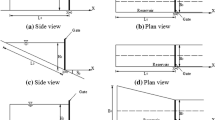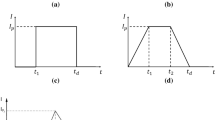Abstract
Most parametric models of earthen dam failure require a breach progression curve to establish an outflow hydrograph, but well-documented breach progression data obtained during dam failure are rarely available. As an alternative, the potential for developing outflow hydrographs from observed variations in reservoir water level is explored. The parameter retrieval process is based on minimizing the difference between the model solution and the water level observations. The retrieved optimal parameters are used to build an outflow hydrograph, which is then linked with a routing model to identify the flood-prone areas downstream. The suggested approach is tested in a case study of a small reservoir and is validated with the inundation area recorded in an on-site investigation. The disparity between the simulated and recorded inundation areas is approximately 7~8%, and the difference in water depth is small at 0.03~0.09 m. Overall, the suggested approach provides reasonable accuracy for the test site.









Similar content being viewed by others
References
Alcrudo F, Mullet J (2007) Description of the Tous dam break case study (Spain). J Hydraul Res 45:45–57
Alvarez M, Puertas J, Peña E, Bermúdez M (2018) Two-dimensional dam-break flood analysis in data-scarce regions: the case study of Chipembe dam, Mozambique. Water 9(6):432. https://doi.org/10.3390/w9060432
Brown RJ, Rogers DCA (1977) Simulation of the hydraulic events during and following the Teton Dam failure. Proc., Dam-Break Flood Routing Workshop. Water Resources Council, Bethesda, Md. 131–163
Costa JE, Schuster RL (1988) The formation and failure of natural dams. Geol Soc Am Bull 100:1054–1068
Cui P, Zhu YY, Han YS, Chen XQ, Zhuang JQ (2009) The 12 may Wenchuan earthquake-induced landslide lakes: distribution and preliminary risk evaluation. Landslides 6(3):209–223
Duan QY, Gupta VK, Sorooshian S (1993) Shuffled complex evolution approach for effective and efficient global minimization. J Optimiz Theor Appl 76:501–521
Duan QY, Sorooshian S, Gupta VK (1994) Optimal use of the SCE-UA global optimization method for calibrating watershed models. J Hydrol 158:265–284
FLO-2D Software, Inc. (2009) FLO-2D, Reference manual. FLO-2D Software Inc., Nutrioso, AZ, USA
Fread DL (1988) BREACH: An erosion model for earthen dam failures. National Weather Service, National Oceanic and Atmospheric Administration, Silver Spring, MD
Froehlich DC (2008) Embankment dam breach parameters and their uncertainties. Journal of Hydraulic Engineering-ASCE 134(12):1708–1721
Froehlich DC (2016) Predicting peak discharge from gradually breached embankment dam. J Hydrol Eng 21(11):04016041
Gallegos HA, Schubert JE, Sander BF (2012) Structural damage prediction in a high-velocity urban dam-break flood: a field-scale assessment of predictive skill. Journal of Engineering Mechanics-ASCE 138:1249–1262
Garcia J, Slejko D, Alvarez L, Peruzza L, Rebez A (2003) Seismic hazard assessment for Cuba and the surrounding areas. Bulletin of Seismological Society of America 93:2563–2590
Hanson GJ, Cook KR, Hunt SL (2005) Physical modeling of overtopping erosion and breach formation of cohesive embankments. Trans Am Soc Agric Eng 48:1783–1794
Liu FU, Wang G, Fu X, Duan J (2012) Physically based simulation of dam breach development for Tangjiashan quake dam, China. Environmental Earth Science 65:1081–1094
Macchione F (2008) Model for predicting floods due to earthen dam breaching. I: formulation and evaluation. J Hydraul Eng 134(12):1688–1696
Mohamed MAA (2002) Embankment breach formation and modeling methods. Ph.D. thesis. Open Univ, Milton Keynes, U.K
Morris MW (2009) Modelling Breach Initiation and Growth. FLOOD site Report T06–08-02
Morris MW (2011) Breaching of Earth Embankments and Dams. PhD Thesis, The Open University, England
Morris MW, Mohamed MAAM, Vaskinn KA (2007) Breach formation: field test and laboratory experiments. J Hydraul Res 45(Extra Issue:9–17
Nash JE, Sutcliffe JV (1970) River flow forecasting through conceptual models, I-A discussion of principles. J Hydrol 10:282–290
Neelz S, Pender G (2013) Bench marking the latest generation of 2D hydraulic modelling packages; report no. SC120002. Environment Agency, Bristol, UK
Nelder JA, Mead RAA (1965) Simplex method for function minimization. Comput J 7:308–313
Ngii.go.kr. (2009) National Geographic Information Institute – Map of Korea – www.ngii.go.kr www.ngii.go.kr/en/popup/map_korea.jsp (Oct. 2009)
Peng M, Zhang LM (2012) Analysis of human risks due to dam break floods-part 2: application to Tangjiashan landslid dam failure. Nat Hazards 64:1899–1923
Pierce MW, Thornton CI, Abt SR (2010) Predicting peak outflow from breached embankment dams. J Hydrol Eng 15(5):338–349
Singh VP (1996) Dam breach modeling technology. Kluwer Academic, Boston
Soares-Frazão S, Canelas R, Cao Z, Cea L, Chaudhry HM, Die Moran A, Kadi KE, Ferreira R, Cadórniga IF, Gonzalez-Ramirez N (2012) Dam-break flows over mobile beds: experiment sand bench mark tests for numerical models. J Hydraul Res 50:364–375
Spada E, Sinagra M, Tucciarelli T, Biondi D (2017) Unsteady State Water Level Analysis for Discharge Hydrograph Estimation in Rivers with Torrential Regime: The Case Study of the February 2016 Flood Event in the Crati River, South Italy. ater(https://www.mdpi.com/2073-444/9/4/288/htm)
Verhulst PF (1845) Mathematical researches into the law of population growth increase. Nouveaux Mémoires de l’Académie Royale des Sciences et Belles-Lettres de Bruxelles 18:1–42 Retrieved Feb 18, 2013
Wahl TL (2004) Uncertainty of predictions for embankment dam breach parameters. Journal of Hydraulic Engineering-ASCE 130(5):389–397
Wahl TL (2010) Dam Breach Modelling - An Overview of Analysis Methods. 2nd Joint Federal Interagency Conference, Las Vegas, NV
Walder JS, O’Connor JE (1997) Methods for predicting peak discharge of floods caused by failure of natural and constructed earth dams. Water Resour Res 33(10):12
Waythomas CF, Walder JS, McGimsey RG, Neal CAA (1996) Catastrophic flood caused by drainage of a caldera lake at Aniackak volcano, Alalska, and implications for volcanic hazards assessment. Geological Society of American Bulletin 108(7):861–871
West M, Morris MW (2018) Hassan A guide to breach prediction, HR Wallingford, UK
Wu W (2013) Simplified physically based model of earthen embankment breaching. Journal of Hydraulic Engineering-ASCE 139(8):837–851
Wu W (2016) Inputs and Outputs of DL Breach – A Simplified Physically Based Dam/Levee Breach Model, Clarkson University, NY
Xu Y, Zhang LM (2009) Breaching parameter for earth and rock-fill dams. Journal of Geotechnical and Geoenvironmental Engineering-ASCE 135(12):1957–1969
Acknowledgments
The author would like to thank Mr. D.H. Go for his kind assistance. This work was supported by the National Research Foundation of Korea (NRF-2017-2017001809).
Author information
Authors and Affiliations
Corresponding author
Ethics declarations
Conflict of Interest
None.
Additional information
Publisher’s Note
Springer Nature remains neutral with regard to jurisdictional claims in published maps and institutional affiliations.
Rights and permissions
About this article
Cite this article
Lee, KH. Simulation of Dam-Breach Outflow Hydrographs Using Water Level Variations. Water Resour Manage 33, 3781–3797 (2019). https://doi.org/10.1007/s11269-019-02341-5
Received:
Accepted:
Published:
Issue Date:
DOI: https://doi.org/10.1007/s11269-019-02341-5




